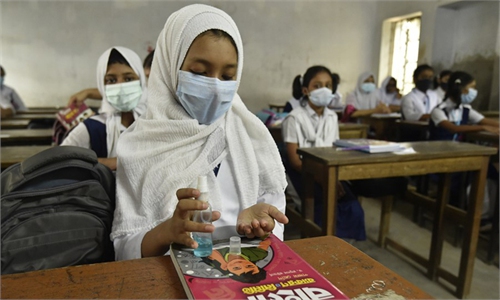Floating farms, salt-resistant rice: Bangladeshis adapt to survive
Innovation required

A farmer standing in an inundated field checks on vegetables growing on seed beds in Dhaka, Bangladesh on September 26, 2021. Photo: AFP
Rising sea levels and violent flooding are already putting tens of millions of lives at risk in Bangladesh, but they bring another problem that threatens the entire nation: Water-logged land and high salinity in streams and soil are killing crops.
Bangladesh ranks seventh for countries most affected by extreme weather in the past two decades, according to the Global Climate Risk Index.
Farmers are desperately trying to adjust to these ever more destructive and unpredictable conditions caused by global warming - from using floating seed beds to developing salt-resistant rice.
"Even 25 years ago, we could grow crops throughout the year... but then water started to stay here seven months. We were clueless how to survive," Altaf Mahmud told AFP.
So they and other local farmers in Mugarjhor, a region 200 kilometers south of Dhaka, revived a century-old technique of using seed beds that sit atop the water.
They stack layers of water hyacinth and bamboo tied together by their roots to create a raft, between 2 and 4 feet (30 to 61 centimeters) high, on which to plant seeds - often using wood chippings and coconut coir as a fertilizer.
This forms a light, floating vegetable garden - bitter gourds, spinach and okra can all be grown this way - able to rise and fall with the water levels.
The floating farms have become community initiatives. In some villages, women spend months preparing the beds before boatmen take them across water-logged fields. Old beds are composted.
'Cannot do it alone'
Ever more frequent cyclones, rising sea levels, floods, erosion, drought and unreliable rains have already displaced millions, either into city slums or abroad.
Those that stay have no choice but to find new ways of working.
Some farmers have stopped growing crops opting instead to grow shrimp in the brackish water, or crab-fattening - capturing wild crabs and feeding them up to then sell - as well as rearing ducks, which fetch a high price in Dhaka eateries.
Bangladesh Rice Research Institute (BRRI) has created new salt-resistant varieties of the staple crop.
"Normal rice does not grow in saline water. Salinity saps the energy of rice stalks," explained scientist Alamgir Hossain.
BRRI has now created a strain that can grow in water with triple the saline levels that normal rice can cope with, he said.
This has offered "new hope" to farmers in coastal regions, where seawater is increasingly encroaching the land, he added.
But Saiful Islam, a climate expert at Bangladesh University of Engineering and Technology, said such efforts are a drop in the ocean.
"We need to spend billions to raise and strengthen embankments along our big coastline. We need to create mangrove forests along the coastal belt to work as natural barriers to cyclones, subsidence and sea level rise."
"We need to build new roads, preserve rain water and create alternate livelihoods for millions of people. Just inventing crops won't do. Bangladesh alone can't do it," Islam told AFP.
He added that Western nations were "responsible for emitting most of the greenhouse gases" and so needed to help.
Islam said Bangladesh received "barely any" of proposed $100 billion dollars set aside by developed nations for adaptation to and mitigation of climate change.
'Farming methods from YouTube'
In some regions, it is ordinary people who lead the charge for change.
"Lungi" Jakir has become a local legend for his hands-on battle against climate change.
A former construction worker, he and friends built an embankment to stop seawater breaching a 6.5-kilometer freshwater canal - effectively saving the 43,000 people it serves in Pakhimara, in southern Bangladesh.
It requires continual repair, but has ensured there's enough fresh water year-round to irrigate traditional crops and even try new ones.
"Salinity is all around us," he told AFP "We got very little assistance from the government... so we have to find our own ways to survive."
"I could migrate to the cities. But I know how hard it is to live in a city slum."
Jakir said he "learnt new farming techniques from YouTube," detailing how they now also use plastic sheeting and raised beds to protect the top soil.
The initiative has been such a success that the area has gone from growing only pumpkins and lentils to supplying fruit and vegetables to other districts and even workers at the nearby coal-fired power station.
Authorities admit farmers have shown them new possibilities for climate challenges.
"We thought hyacinth is a weed and should be thrown out of the ponds but it has opened up a vast opportunity of farming," Mohammad Shahidullah, a former government agriculture chief for Mugarjhor, said of the floating vegetable gardens.
"The state-run research institutes didn't know anything about it," he added.
Officials are keen to "popularize" the technique in other water-logged regions, explained Shahidullah.
Farmer Mahmud said some of his families were now being recruited by the government to train others in this form of soil-free agriculture.
Vegetable grower Mostofa was hopeful they can weather the changing climate.
He told AFP: "Now thanks to the floating farm, we can grow our food."



